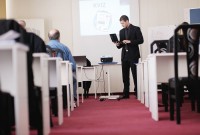- Home
- Business Processes
- Industry Knowledge
- Aerospace Industry
- Automotive Industry
- Banking Domain
- BFSI Industry
- Consumer/ FMCG Industry
- Chemicals Industry
- Engineering & Construction
- Energy Industry
- Education Domain
- Finance Domain
- Hospitality Domain
- Healthcare Industry
- Insurance Domain
- Retail Industry
- Travel and Tourism Domain
- Telecom Industry
- Leadership Skills
- eLearning
- Home
- Leadership
- Leadership Theories
- Cognitive Resource Theory
Cognitive Resource Theory
The cognitive resource theory states the influence of the leader's resources on his or her reaction to stress. The cognitive resources of a leader are experience, intelligence, competence, and task-relevant knowledge. Stress is common in resource managing situations, and this cognitive theory emphasizes how intelligence and experience are each best under different stress situations. This theory is the reconceptualization of the Fiedler model.
In the early 1990s, the original model of Fiedler was re-conceptualized by Fiedler and his associate Joe Garcia, as Cognitive Resource Theory. In this model, the focus has been laid on the role of stress as a form of situational un-favorableness and how a leader’s intelligence and experience influence her/his reaction to stress.
What is meant by cognition?
Cognition is the mental action or process of acquiring knowledge and understanding through thought, experience, and the senses. Good examples of cognition are learning and our ability to reason through logic. Cognitive processes use existing knowledge and generate new knowledge. Cognitive processes are analyzed from different perspectives within different contexts like psychiatry, psychology, education, philosophy, and computer science.
Cognitive Resource Theory of Leadership
The Contingency Model developed by Fiedler was criticized for its lack of flexibility and also over the accuracy of the LPC scale. Fiedler then went on to develop the Cognitive Resource Theory (CRT) which takes into account the personality of the leader, degree of situational stress, and group-leader relations.
The assumption behind this theory is that stress impacts the ability to make decisions. It is the enemy of rationality and a leader cannot think in a logical and analytical manner if she/he is under a high level of stress. According to this proposition, the importance of a leader’s intelligence and experience to effectiveness differs under low and high-stress situations.
Fiedler and Gracia state that a leader’s intellectual ability correlates positively with performance under low stress but negatively under high stress. And conversely, a leader’s experience correlates negatively with performance under low stress but positively under high stress.
Thus, according to Fiedler and Gracia, the level of stress in a situation, determines whether an individual’s intelligence or experience will contribute to leadership performance.
Predictions of Cognitive Resource Theory
The Cognitive Resource theory predicts that the leader's abilities and intelligence can aid organizational success only when leaders adopt a directive leadership style, the situation is stress-free, the group members are supportive and the task requires high intellect. These attributes are discussed below:
1. Directive Approach
When a leader is better in cognitive abilities like intelligence, planning, and decision-making, he must follow a directive approach to improve the overall performance of the team. He needs to communicate to the group what to do, to ensure his plans and decisions are implemented, hence improving the overall performance of the group.
When the group and the people on the group are better than the leader in cognitive abilities, then the leader should choose a non-directive approach. He should seek ideas from the group and identify the best approach/idea and move ahead with the same.
A leader's cognitive ability contributes to the performance of the team only when the leader uses the directive leadership style.
2. Impact of Stress
Stress has a direct co-relation with intelligence and decision quality.
When there is a low stress, then intelligence is fully functional and makes an optimal contribution.
When there is high stress, natural intelligence does not make any difference, but may also have a negative effect.
3. Supportive Group Members
A leader's abilities will contribute to group performance only when group members are supportive of the leader and his goals. In such a situation leader's directions can be easily followed and implemented.
4. Cognitively Demanding Tasks
The intellectual abilities and intelligence of the leader can only be utilized efficiently in difficult, cognitively demanding tasks.
What are the practical applications of Cognitive Resource Theory?
The theory proposes the style of leadership required depending on three variables – the degree of stress, situational control, and task structure.
Leaders should be trained on stress management so that a leader's intellect can be most effectively utilized and also to train leaders to take a directive approach when their knowledge will benefit the group but a less directive approach when group member abilities will contribute to performance.
Based on this theory, for a given situation, depending on the level of the stress, leaders can decide on whether to rely on intelligence or on experience. For low-stress situations, one should rely on intelligence; however, for high-stress situations, one should rely on experience.
In high-stress situations, leaders who are more experienced will produce more quality results. In high-stress situations, rational solutions are generally not available and hence intelligence will not be able to support the decision-making process, whereas previous experience can allow the leader to react.
What are the cognitive resources of the self?
The cognitive resources of a leader refer to their experience, intelligence, competence, and task-relevant knowledge. A leader's knowledge can contribute to performance if it is efficiently communicated, hence requiring a directive leader and also a compliant group that is willing to undertake the commands of the leader.
Related Links
You May Also Like
-
Functional leadership theory addresses specific leader behaviors that are expected to contribute most to the organizational effectiveness by focusing on how the leadership process occurs. The leader should ensure that all needs of the group get addressed.
-
The ten most important qualities that define a good leader are self-awareness, interpersonal and communication skills, ethical values, organizational consciousness, self-confidence, adaptability and flexibility, imagination and creativity, focus & result-orientation, continuous self-development and accountability and ownership for his actions. These ten qualities of leadership every good leader should possess to a certain extent and must continually strive to develop them.
-
Normative leadership theories are built on moral principles and tell leaders how they ought to act. Victor Vroom formulated the normative model of leadership that specifically address leader behavior explicitly built on moral principles or norms. Normative leadership theories tell leaders how they should act to raise the moral performance inside the working group and manage their different responsibilities.
-
Transformational Theories of Leadership
Transformational leadership theories focus on the leadership approach where the leader encourages, inspires employees to innovate and create positive and valuable organizational change. A transformational leader works towards “transforming” the culture to one that cultivates trust, mutual admiration, loyalty, and respect with the end goal of developing followers into leaders. Transformational leaders are known to be visionary, inspiring, daring, risk-takers, and thoughtful.
-
Behavioral Theories of Leadership
Behavioral Theory of leadership is a big leap from Trait Theory, as it was developed scientifically by conducting behaviour focused studies. The theory emphasizes that leadership capability can be learned, rather than being inherent. This theory is based on the principle that a leader's behaviors can be conditioned in a manner that one can have a specific response to specific stimuli.
-
Idiosyncrasy Credit Model of Leadership builds upon the awareness that when the emergent leader meets the team's expectations, idiosyncrasy credits are awarded. These credits depend on how the leader fulfilled follower's expectations and what is the impact of the leader's decisions on the follower. When the balance of credits shifts, another leader will emerge.
-
Situational Theories of Leadership
The situational theories of leadership assume that the most effective style of leadership depends from situation to situation. Situational leadership is a leadership style in which the leader must adjust to match the development needs of the followers. They must adapt varying behaviors to strike the right balance between task & relationship based on different levels of maturity of followers and also as followers develop and cultivate their skills.
-
Role theory is a concept in sociology and the role theory of leadership borrows these concepts to explain how people adapt to specific organizational and leadership roles. How the leaders and followers in an organizational context define their own roles, define the roles of others, how people act in their roles and how people expect people to act in their roles within the organization.
-
Rensis Likert studied the patterns and styles of managers and developed four management systems known as Likert's management systems. These styles developed by him are known as Likert management systems. System 1 - Exploitative Authoritative; System 2 - Benevolent Authoritative; System 3 - Consultative and System 4 - Participative.
-
The two-factor theory also known as Herzberg's motivation-hygiene theory and dual-factor theory. This motivator-hygiene theory states that certain factors cause job satisfaction whereas certain separate factors cause dissatisfaction in the workplace. An organization can adjust these factors to influence motivation. These factors are respectively termed as motivators and hygiene factors.
Explore Our Free Training Articles or
Sign Up to Start With Our eLearning Courses

About Us
Learning
© 2023 TechnoFunc, All Rights Reserved










